 Above, the nose fairing of the axial fan system offered by CFE Technology GmbH. The system offers fully
Above, the nose fairing of the axial fan system offered by CFE Technology GmbH. The system offers fully
automatic
operation, a smaller overall footprint, and significantly improved airflow control over
competing centrifugal
fan-based solutions. (Photo: CFE)
A couple of ventilation projects recently
described to E&MJ showcase bold innovation
meant to ensure the success of
the solutions deployed. They also revealed
how important it is to have plans
in place to deal with the more predictable,
inescapable challenges. Based on
a couple other headlines from the space,
it is apparently crucial for suppliers to
strive to offer both.
Turnstone Cools Hell
Turnstone Industrial Solutions, a joint
venture between ABC Technology Group
USA and Calandra Group LLC, completed
a couple big projects in late 2019 and
early 2020 that show the burgeoning capabilities
of the new company.
While the company is best known for
its HardLine ducting, the projects also
demonstrated its engineering expertise,
Bryon Cerklefskie, U.S. sales manager,
Turnstone, reported.
For both jobs, Turnstone was brought
in to assess and consult. It was then
tasked with engineering the solutions. For
both jobs, the results beat expectations
and led to new contracts.
The first job was at a salt mine in New
York and launched in September 2019.
“We were contracted to assess the project,
then tasked with developing an engineered
solution,” Cerklefskie said.
The problem was the system, which
used 30-in. fiberglass ducting, “had
difficulty clearing out dust and fumes
post blast.”
That created long re-entry times,
which affected productivity.
“The mine shot on third shift, and
was losing a lot of production time on
day shift while the blast contaminants
cleared,” Cerklefskie said.
Turnstone engineered a face ventilation
system using 30-in. HardLine-MAX
ducting.
“We switched to our product and then
we did the engineering to calculate the
optimal length of the runs and the type of
transitions,” Cerklefskie said.
AirSTOP curtains were also installed.
“The new configuration comes with double
seams, grommet holes, extra height
for muck, and zipper doors,” Turnstone
reported. “All of these features allow for a
better seal and lower leakage.”
When reality clashed with plans, “we
had to innovate a bit,” Cerklefskie said.
“The openings in there are so big, so different
at times, that you’ve got to use a
little bit of common sense mixed with
very sound engineering, and then try it.”
Common sense told Turnstone to split
the main line to the face, and to put in a
damper system to “cut the air back and
forth and push it different ways,” Cerklefskie
said.
The result is effective evacuation of
the air at the face. “It allows you to aim
the air not just straight at the face, but
actually to turn a corner so then you could
manipulate that regulator for different
times and different needs to accommodate
whatever you need,” he said.
“That is something they didn’t have
before. They weren’t sweeping the faces
as effectively as they could have been,”
Cerklefskie said. “Now the miners have
control where, during these phases, if
they see something a little bit different,
they can adjust the system to manage it.
Before they just had a start-stop button
for the fan and that is it.”
After the project, an assessment followed.
A hot-wire anemometer showed
that the ducting in all five tunnels provided
an airflow of a minimum of 15,000
cubic feet per minute (cfm).
“The logs show a drastic decrease in
NO2 and CO2 concentrations using the
new system, which means that the air
is being circulated more effectively than
before,” Turnstone reported. “On average,
the new system has decreased re-entry
time by two hours.”
Often, within a half hour of blasts, the
area can be worked. “It went from can’t
mine, can’t produce, can’t do anything
until the air clears, to the miners are in
there and mucking away,” Cerklefskie
said. “They loved it.”
And they loved Turnstone. The salt
mining company and Turnstone then
moved to optimize tubing size. Next it
“is going to roll out to their sister mines,”
Cerklefskie said.
 At a salt mine in New York, Turnstone Industrial Solutions
installs
At a salt mine in New York, Turnstone Industrial Solutions
installs
30-in. HardLine-MAX ducting. It conducted 15,000
cfm to the face
and led to a ‘big win’ contract for a turnkey
package.
(Photo: Turnstone Industrial Solutions)
“We’ve gained that trust and we are
going to spec out and do the full turnkey
package for them,” he said. “It was a big
win for us.”
It was the start of a streak. Turnstone
partnered with a gold mine in Nevada late
last year on a ventilation system optimization
project that ultimately more than
doubled the airflow to three faces.
Turnstone was brought in to first assess
and then engineer the solution.
The miner presented historical data that
showed the predecessor system, on average,
could only get less than half the air
produced by the fans to the faces. Most of
the fan fleet was more than 20 years old.
Cerklefskie said the old system’s performance
was basically the sum of its
parts. “They were using a flexible-type
ducting that is very high resistance. It was
a metal-spiral-wrapped fabric tubing,” he
said. “That has got the highest resistance
out there. That was a big part of it.”
In one section, the mine used 26-in.
PVC hardline and 36-in. round ventbag.
PVC becomes brittle when used to
conduct air, Cerklefskie said.
“This stuff is heavy and they were limited
to a round profile,” he said. “It was
a little less expensive and was popular
back in the day.” What was saved in initial
capex was later lost as opex, he said.
For example, the fan produced 24,000
cfm, and the tubing and ducting managed
to deliver 9,900 cfm to the face.
“Leakage and shock loss were 58.8%,”
the miner reported. That translated to a
pressure loss of 93%.
Turnstone and the miner upgraded the
section with 48-in. oval HardLine-MAX
tubing and 42-in. TwinDuct zipper ventbag.
A new fan was installed.
The fan produced 41,400 cfm, and the
tubing delivered 40,200 cfm to the face.
“Leakage and shock loss were 3%,”
the miner reported. That translated to a
pressure loss of 34.9%.
Airflow from the fan increased by
17,500 cfm or almost 73%. Airflow delivered
to the face increased a whopping
30,300 cfm or 307%.
“That was achieved by combining
resources with the mine. We shared
data, combined expertise and then laid
everything out properly,” Cerklefskie
said. “We really dove in together to understand
what they needed and understand
it very clearly. We programmed it
to succeed, rather than hoping for the
best.”
The temperature at the face averaged
67°F after the upgrade, the miner reported.
Which is of almost metaphysical signifi
cance, Cerklefskie said.
“It was the lowest working area in the
mine and was called Hell,” he said. “At
the time, it was well over 100°F.” With
the humidity, few could take more than
15 minutes in the work area at a time.
“After that initial install, they brought
the whole management group down and
stood at the end of the tube,” Cerklefskie
said, “and all of them were comfortable.”
Afterward, the miner and Turnstone
upgraded another section with two faces.
The section used a 2012 model, 42-in.,
100-hp Jetair fan, with 38-in. PVC and
36-in. round ventbag.
The fan produced 23,000 cfm. Of
that, the tubing delivered 7,300 cfm to
each face. That translates to an airflow
loss of 68% and a pressure loss of 81%.
The mine installed a 2018 model,
44-in., 150-hp, two-stage Spendrup fan;
and 48-in. oval HardLine-MAX and 42-in.
TwinDuct zipper ventbag.
The new fan produced an airflow of
44,600 cfm, an increase of 21,600 cfm
or 94%.
Airflow at one of the faces was 14,600
cfm, an increase of 7,300 cfm, or 100%.
At the other face, it increased by 10,500
cfm, or 144%, to 17,800 cfm.
“The 48-in. HardLine-MAX and 42-
in. TwinDuct zipper ventbag reduced
airflow loss from 68% to 27%,” the miner
reported.
Cerklefskie described such results as
“pretty crazy.” At times, “they were losing
like 90% of their pressure from leakage.
We got the volume loss down to 5%,” he
said. “That is huge.”
 A gold mine in Washington state contracts Turnstone for more than 1,000 ft of 60-in. oval
A gold mine in Washington state contracts Turnstone for more than 1,000 ft of 60-in. oval
HardLine ducting. The
HDPE-based polymer tubing maximizes airflow for the space available.
(Photo: Turnstone)
It proved to be a coup. “We gained a
lot of trust,” Cerklefskie said. That trust
brought new work. Turnstone now has
product on 10 different levels at the mine.
“It paved the way for us to keep optimizing
their system and implementing
more, not only of our rigid tubing, but our
flexible tubing, zipper couplings and other
features that folks there have shied away
from,” Cerklefskie said. “Now we’ve been able to come out and prove that our stuff is
reliable,” he said. “They can trust us and
ever since then they’ve never looked back.”
CFE’s Axial Fan Reverses Fast
CFE Technology GmbH reported its axial
fan system, with an electric motor, variable
pitch control and push-button-reverse
functionality, is capable of reducing
the time needed to go from normal to reverse
operation to less than 10 minutes.
Norbert Kuhn, general manager, CFE
said, the system offers “significantly higher
efficiency” and “decisively increases
the operational safety of the mines, while
at the same time reducing costs.”
The system offers several advantages
that include fully automatic operation, a
smaller overall footprint, and significantly
improved airflow control over competing
centrifugal fan-based solutions. Heightened
control comes from integrated blade
adjustment, according to a report by CFE.
“This adjustment consists of a central
planetary gear and bevel gears that are directly
connected to the blades,” CFE reported.
“In the adjustment mode, the sun
gear is moved by a hydraulically or electromechanically
driven swivel drive. This
movement is transmitted to the bevel
gears of the blades via the planetary gear,
which changes the angle of the blades.”
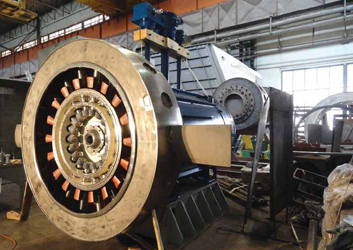 For CFE’s flagship axial fan system, with push-button reverse capability, the impeller
For CFE’s flagship axial fan system, with push-button reverse capability, the impeller
assembly is mounted on a
shaft end from the main motor. An actuator on the impeller
hub then controls the blades in flight. (Photo: CFE)
A sensor on the rotary actuator monitors
the change in angle.
“The value of the sensor is permanent
compared with the proportional valve attached
to the hydraulic unit and, if necessary,
corrected,” CFE reported. “With this
technology, the blades can be adjusted to
an angle of more than 220°. This ensures
reversing operation with a flow rate signifi-
cantly above 80% of normal operation.”
The design was first deployed roughly
a decade ago at Janina coal mine in Poland,
which was operating outdated centrifugal
fans. The miner needed a system
that could reverse airflow in an emergency.
It was also looking to cut costs.
“Two centrifugal fans with lower effi
ciency were replaced by one axial fan
for reversing operation and variable pitch
control,” Kuhn said. “This made it possible
to significantly optimize the mine’s
ventilation while at the same time reducing
energy costs.”
The new fan motor was rated at 1.2
MW and offered a speed of 745 rpm. Auxiliary
devices include the hydraulic systems
for controlling the blades and brake.
The system features silencer baffles to
absorb sound. Dedicated centrifugal fans in
external arrangement cool the drive motors.
The system is designed for optimal operations
in various contingencies. It has
an emergency power supply, and an integrated
emergency backup fan on standby.
If the main power supply goes, the impeller
blades return to a neutral position
and the damper-louvres close. While the
system was designed for unmanned operation,
it can also be operated from the
main control room.
The system was commissioned in
February 2012. “Results after commissioning
exceeded the guaranteed values
in both normal and reversing operation
by more than 10%,” Kuhn said. “Due to
the higher efficiency and better reliability
of the fans from CFE Technology GmbH,
the ventilation of the mine is much more
stable and the miners’ work is also safer.”
Those initial results were duplicated
at later deployments, including one in
China and one in Belarus, he said.
“Despite the higher capital and maintenance
costs, total savings of more than
15% compared to a conventional design
can be achieved, so the payback period
is extremely short,” Kuhn said. “This has
been proven in several applications.”
Currently CFE is installing an axial fan
system at a plant in Kazakhstan.
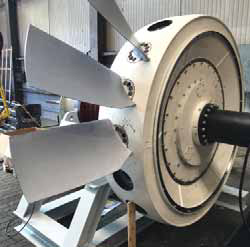 The rotor assembly for a CFE axial fan system to
be deployed
The rotor assembly for a CFE axial fan system to
be deployed
to an operation in Kazakhstan. (Photo: CFE)
The deployment at Janina illustrates
the viability of the system as well as the
company’s expertise at applications engineering,
Kuhn said. “CFE is able to solve
almost all aerodynamic problems in the
shortest time possible with programs developed
in house,” he said. “This significantly
shortens the planning phases and makes
them more cost effective for the customer.”
Zitrón Plants US Beachhead
In early 2020, Zitrón S.A., headquartered
in Asturias, Spain, launched the subsidiary
Zitrón USA.
Zitrón’s stateside facility is located
in Bluefield, West Virginia, and spans 70,000 ft2, with warehousing, manufacturing
and service capabilities.
The development is part of the company’s
mission to expand its global presence,
according to Encarna Quesada,
marketing director, Zitrón S.A.
“The goal is to meet the growing demand
from the North American market,”
she said. “There was a real demand from
the U.S. market for us to be present in
the country, and we also have found a reliable
local partner.”
The company, founded in 1963, is
known for its custom fans. “Zitrón also
provides complete solutions,” Quesada
said. “Zitrón provides optimized ventilation
design, manufacturing fans with varying
capabilities for diverse applications.”
Joe Finn, a contracted U.S. representative
of the company, described Zitrón as
the world’s largest axial fan engineering
and manufacturing firm.
Zitrón reported it has installed 20,000
fans in a half-century. It boasts of having
a mining fan operational in the most
northerly inhabited place on earth, as well
as of numerous more recent projects elsewhere
around the world.
For example, the supplier installed three
1,300-kW vertical fans at Booysendal platinum
mine in South Africa; two 630-kW horizontal
fans and switch rooms at Newmont’s
Tanami mine in Australia; a 2,800-hp fan
as part of a turnkey project for Minera Saucito
silver mine in Mexico; a 1,200-hp, 10-
ft fan at the Kilyati mine in Finland; two
1,500-hp ATEX fans and switch rooms for
Polyak mine in Turkey; and a 575-kW fan at
Capstone Gold mine in Mexico.
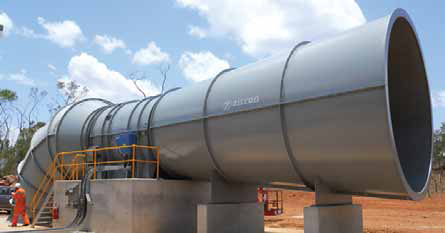 In 2012, Zitrón S.A. installs the 630-kW ZVN 1-30-630/8 fan system at Pajingo gold mine in Queensland,
In 2012, Zitrón S.A. installs the 630-kW ZVN 1-30-630/8 fan system at Pajingo gold mine in Queensland,
Australia.
(Photo: Zitrón S.A.)
As prolific as it is, and despite offering
relatively short lead times, Zitrón focuses
on quality, tailored solutions made possible
by its superior assets, Quesada said.
Zitrón reportedly has the world’s largest
testing facility of its kind. It is longer
than a football field, is AMCA certified,
and can test fans up to 3,300 hp and 19
ft in diameter.
The company reportedly also has “the
world’s largest database of factory performance
tested fans.”
The two superlatives give Zitrón the
ability to custom design fans using empirical
data followed by rigorous factory
acceptance testing. “Fans from 15 hp
to 12,500 hp, and with diameters from
30 in. to 17 ft, are designed, fabricated,
tested and supplied all over the world,”
the company reported.
The KPIs from those fans prove their
viability. An internal study of 4,700 fans,
all larger than 48-in. in diameter, found
that the mean time between impeller
failures was 13,000 hours, and between
motor failures was 16,600 hours. Availability
was 99.9%.
Caleb Warden, sales director, Zitrón
USA, said the company’s superior quality
solutions arise in part from a dedicated
customer focus. “Customers choose
Zitrón because we are a trusted partner
who will work tirelessly to deliver the optimal
ventilation solution for each project,”
he said. “Our passion in solving design
challenges makes each project as unique
as our clients.”
 In 2015, Zitrón S.A. installs the massive
In 2015, Zitrón S.A. installs the massive
5,600-kW
ZVNv 1-36-1400/8 fan system at the
Dugald River
mine in Queensland, Australia.
(Photo: Zitrón S.A.)
Other than fans, Zitrón supplies diffusers,
control panels, sound attenuators
and winches. It also supplies safety solutions,
such as dust extraction technology,
which “provides safer, cost-effective control
of combustible dust,” Warden said.
Zitrón offers a machine health monitoring
solution for managing ventilation
systems for better efficiency. “Control and
monitoring systems are based on continuous
acquisition of data, and help increase
productivity and safety in mines,”
he said. “It is a revolutionary approach
that offers an efficient way of automating
and optimizing mine ventilation, providing
safer working conditions, productivity
improvements and energy savings.”
Beyond the launch and the new partnership,
the company also recently increased
factory floor space. Such routine investments
in capacity, R&D, and in new materials
and techniques “have positioned Zitrón
as the industry benchmark,” Quesada said.
Nonetheless, “our most valuable asset
is the 462 professionals that make up
the global Zitrón team,” she said. “We
should not forget that Zitrón was built on
the shoulders of our employees and our
success is driven by our people.”
M&RC Charges Ahead
at Palabora
Murray & Roberts Cementation (M&RC)
reported it completed the pre-sinking
phase of a 1,200-m-deep ventilation
shaft for Palabora Copper’s new LIFT II
underground block cave mining area.
Palabora Copper, located in South Africa’s
Limpopo Province, is described as the
country’s sole producer of refined copper.
The shaft sinking contractor started
the 8.5-m-diameter shaft in early 2019.
Pre-sinking went to a depth of roughly 50
m. M&RC expects the shaft to be complete
in Q3 2022.
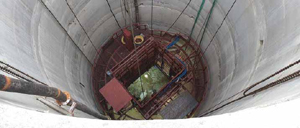 During the pre-sink phase for a 1,200-m-deep ventilation shaft at Palabora
During the pre-sink phase for a 1,200-m-deep ventilation shaft at Palabora
Copper, in South Africa, water
incursions occurred down to the 50-m level.
To answer, Murray & Roberts Cementation use a quick-setting chemical
compound, concrete lined the barrel, and resealed behind the lining.
(Photo: M&RC)
Graham Chamberlain, project executive,
mine development, M&RC, said
the main challenges thus far, aside from
those presented by COVID-19, were from
unconsolidated rock and water.
“We had water intersections at various
levels down to 50 m below surface,”
he said. “The type of water inflows
we encountered were from various sources
underground and easily found their
way into the excavation around the
fractured ground.”
The company has a few solutions it
deploys in such situations. “We made
use of a quick-setting chemical compound
in close proximity to the shaft,”
Chamberlain said. “We then concrete
lined the barrel and resealed behind
the lining.”
Going from the pre-sink phase to the
main sink phase involves removing the
temporary infrastructure and installing
the permanent sinking infrastructure.
“The main components are the winding
plant for the kibbles and stage, the
headgear and tipping arrangements, and
all the services and controls systems required
to operate the shaft,” Chamberlain
said. “We have a separate, highly skilled
in-house team that does this.”
The predicted challenges to the main
sink piece relate to geology. “The other
challenges are getting the teams functioning
smoothly with all the new technology,”
he said.
“Our preparations and methodology
is to cater for the worst known condition
and be ready with a quick response plan
for the unknown conditions,” Chamberlain
said. “From experience, we also have
backup emergency plans and equipment
on standby. In respect to the teams, we have chosen individuals with both a good
safety and team player attitude.”
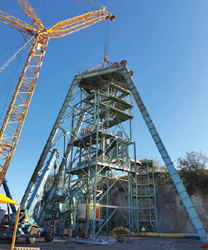 A crawler crane lowers the headgear assembly
A crawler crane lowers the headgear assembly
during the pre-sink phase for
a ventilation shaft at
Palabora Copper. M&RC reports the pre-sink phase
is now
complete. The shaft is expected to be
completed in Q3 2022. (Photo: M&RC)
Advanced machinery in use includes
high-penetration-rate hydraulic drills on
robotic arms nested on the shaft-sinking
stage. The arrangement allows drilling at
any position in the shaft without worker
contact with the drills.
“Our drilling equipment has been
modified for efficiencies and noise reduction,”
Chamberlain said.
Other newer solutions include the winding
plant, which has been upgraded with
state-of-the-art safety systems, he said.
“Our explosive delivery and placement systems
are also improved and apply the most
modern information capturing systems.”
To deal with poor ground conditions,
M&RC takes the shaft lining to the bottom
of the shaft during sinking, as opposed to
taking it to roughly 20 m from the bottom.
“Our lining approach is applied with
the use of a modified version of the traditional
shuttering and our specialized
concrete mixes, which we design for this
specific purpose,” Chamberlain said.
“The mixes are prepared and delivered by
our on-site batch plant.”
Despite the size
of the shaft, Chamberlain
said, ultimately
more time
is spent by management
dealing with
“outside influences”
than is spent
internally running
the project.
“You cannot
spend enough time
educating and communicating
to all interested
and affected
parties,” he said.
“Being involved
with the community
and showing tangible
benefits toward
local employment
and skills development,
coupled with
supporting the local
businesses in the
area, have been key
factors for a smooth
project thus far.”
As featured in Womp 2020 Vol 10 - www.womp-int.com








